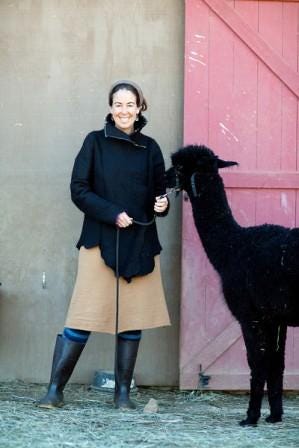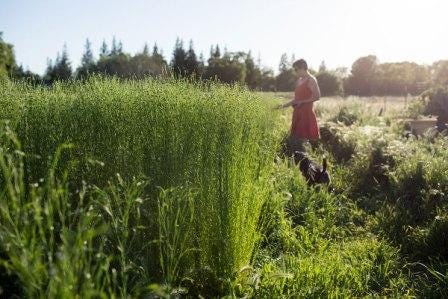Welcome to Terra Firma by Courtney White. I’ve spent my life prospecting for innovative, practical, and collaborative answers to pressing problems involving land and people, sharing them with others. I’d like to share them with you!
Don’t miss the next issue, sign up here:
News Item: Here’s a great story about regenerative agriculture in the Southwest titled ‘Agriculture Is Part of the Climate Change Problem. Colorado Wants Farmers’ Soil to Be Part of the Solution.’ It links land, water, people, and profit all together (see).
In the previous issues I’ve tried to paint a broad picture of regenerative agriculture, the importance of confronting paradigms, the need to work collaboratively in the radical center, and the role of carbon, the essential element.
In this newsletter, I will discuss an exciting concept that pulls all these different pieces together into a hopeful whole. It’s called a fibershed, which is like a watershed or a foodshed except for your clothes!

Fibershed is a place, a movement, and an organization (and a book, see below).
It started one day in 2009 when Rebecca Burgess, a natural dye and fiber educator in the Bay Area, waited in an airport terminal to catch a flight home. Watching yet another news story about American troops being deployed to the Middle East, she realized that everything surrounding her had its origins in oil and conflict – the jet fuel, the plastic chair she sat in, the carpeting below her feet. That included her clothes too.
Rebecca realized she needed to walk her talk about progressive agriculture, ecological integrity, and addressing climate change starting with what she wore every day. She decided challenge herself to live for twelve months in a wardrobe entirely sourced from natural fibers grown and assembled within a 150-mile radius of her home north of San Francisco.
Many people don’t realize that clothes are an agricultural product. Wool comes from sheep and goats, cotton and linen from plants, silk from silkworms. Farms and ranches have been the source of the raw material for our garments for thousands of years. It’s only been in the past few decades that fossil oil has replaced natural fibers and dyes as the primary ingredient in our clothing.
Most people also don’t realize the damage our oil-derived clothes do to our physical health, the environment, and the planet. Petroleum-based fibers and dyes are packed with toxic chemicals, many of them unregulated, whose effect on human health is poorly understood. Our skin is the largest organ on our body. We should be very careful what we put next to it. Some of these chemicals are endocrine disrupters, for example, which can have devastating effects on our immune systems. There are other consequences. Micro-plastics from clothing, for instance, are polluting our oceans. The list goes on.
Then there are all the terrible costs of manufacturing our clothes, including the tragic work conditions in sweatshop factories around the world, the use of child labor, and the immense carbon footprint of transporting these garments to the marketplace.
Rebecca decided she needed to get away from these unhealthy systems for a year and focus instead on positive, local, regenerative relationships and practices. Her goal was inspired by the philosophy of the Slow Food movement, founded in Italy by Carlo Petrini, which advocates for local food traditions that are good, clean, and fair.
Her vision was also influenced by the geography-based approach to managing our water called a watershed. As Rebecca embarked on her year-long wardrobe experiment, she coined a term for her place-based approach. She called it a fibershed.
Here’s Rebecca wearing locally-sourced clothes:

Rebecca’s wardrobe year was a big success, drawing in enthusiastic textile artisans, designers, sewers, dyers, and natural fiber producers, including organic cotton farmer and plant breeder Sally Fox who has developed new varieties of naturally colored cotton. In creating the wardrobe, cross-links were established between different parts of the natural fiber world, energizing a radical center focused on the origins of their clothing. The year concluded with a gala celebration that featured the work of these community members.
For Rebecca, the next step was to found a nonprofit organization in order to provide support to the quickly expanding fibershed community, organize events, and continue to connect the dots between farmers, designers, weavers, and wearers. Central to the educational mission of Fibershed was the promotion of regenerative agricultural practices, including holistic management of livestock and soil carbon-building.
Fibersheds put it all together into a practical, natural, and hopeful whole. It based in the philosophy that nature still knows best, whether it involves the role of animals on the land, promoting life in the soil, keeping the ground covered with plants, building up soil carbon, generating local jobs, and using ingredients sourced from nature. Fibersheds depend on biological and human relationships that have worked together successfully for a very long time.
Fibershed has also become a movement, with local efforts springing up across the U.S., Canada, the United Kingdom, and beyond. For example, there has been a surge recently in flax farming in America. Once a major part of our agricultural economy, flax plants produce linen, a useful fabric in both cold and warm climates. However, as the industry turned to petroleum-based garments, flax farming faded. Today, it is seeing new life as the local fiber movement grows.
Here’s a ‘Farm to Garment’ photo from the Meridian Jacobs ranch in California:

Fibershed is also a book – one that I had the honor of co-authoring with Rebecca. Here is her vision in her own words:
“With every passing day we increasingly see, hear, and feel the destructive effects of our complicity in perpetuating systems that were designed to make us the primary recipient of the planet’s finite resources. Fibershed asks: how can we work together to transform contemporary cultural and economic systems to benefit all life and promote regeneration? And how can we do it without perpetuating consequences that force the hand of another set of technological solutions?”
“As we learn the fundamentals of the carbon, water, and nutrient cycles, we understand that the earth’s true ecological carrying capacity is directly connected to regenerative capacity of natural resources such as the soil and the fiber it grows. This knowledge begs a deep human question: how will we care for, protect, and use what the earth provides in a manner that leaves the land and water more diverse and productive than when we found it?”
That’s what Terra Firma is all about: looking at the world in a positive way, grounded in nature, experience, facts, and hope.
Resources (there are a lot to choose from):
Fibershed: Growing a Movement of Farmers, Fashion Activists, and Makers for a New Textile Economy by Rebecca Burgess and yours truly, 2019, https://www.chelseagreen.com/product/fibershed/
Here’s a short article (and an excerpt from the book) titled What Do Clothes Have to Do with Agriculture: https://www.momsacrossamerica.com/what_do_clothes_have_to_do_with_agriculture?utm_campaign=clothes_agriculture&utm_medium=email&utm_source=yesmaam
Harvesting Color: How to Find Plants and Make Natural Dyes by Rebecca Burgess, 2011, https://www.workman.com/products/harvesting-color
Overdressed: the Shockingly High Cost of Cheap Fashion by Elizabeth Cline, 2012, https://www.elizabethclinebooks.com/overdressed
A New Textiles Economy a Report by the Ellen MacArthur Foundation (PDF), https://www.ellenmacarthurfoundation.org/assets/downloads/publications/A-New-Textiles-Economy_Full-Report.pdf
Video:
Here’s Rebecca speaking at the 2015 Quivira Coalition conference - a talk that I highly recommend (see).
Here’s a 2-minute video featuring Rebecca that introduces the Fibershed concept (see).
Here’s a 6-minute video about Fibershed from the Bioneers organization (see).
Here are nine short videos about various Fibersheds (see).
Here’s a great 7-minute video about the negative costs of the Fast Fashion industry, made by The Economist magazine (see).
Here’s a thought-provoking 6-minute video about the life cycle of a T-shirt (see).
Web Sites:
Fibershed (the organization): https://www.fibershed.com/
Slow Food International: https://www.slowfood.com/

COURTNEY’S CORNER
I originally profiled Rebecca and her work in my 2015 book Two Percent Solutions for the Planet: 50 Low-cost, Low-tech, Nature-based Practices for Combatting Hunger, Drought, and Climate Change published by Chelsea Green: https://www.chelseagreen.com/product/two-percent-solutions-for-the-planet/
Here is a review of the book, which offers easy-to-digest profiles of a wide variety of carbon-friendly practices and approaches: https://www.ecolandscaping.org/12/resources/book-reviews/book-review-two-percent-solutions-for-the-planet/
My selected Terra Firma photo for the week - flax growing in northern California:

Credit: https://www.paigegreenphotography.com/
Thank you for reading this issue of my newsletter. It is published every Thursday morning – for free! Please consider sharing it with a friend or two or three:
About me: For twenty years I worked to create a radical center among ranchers, conservationists, agencies and others focused on western working landscapes. Today, I am a full-time writer. My nonfiction books include Forewords by Wendell Berry and Michael Pollan. For more information or to contact me see: www.jcourtneywhite.com/
I am also the author of a MYSTERY series called the Sun Ranch Saga, set on a working cattle ranch in northern New Mexico. The first book, titled The Sun, is available and I’m working on the sequel. See: http://jcourtneywhite.com/fiction/
Terra Firma means ‘solid earth’ or ‘firm ground’ in contrast to air or water. Historically, it was first used by the Republic of Venice to describe its holdings on the Italian mainland.

